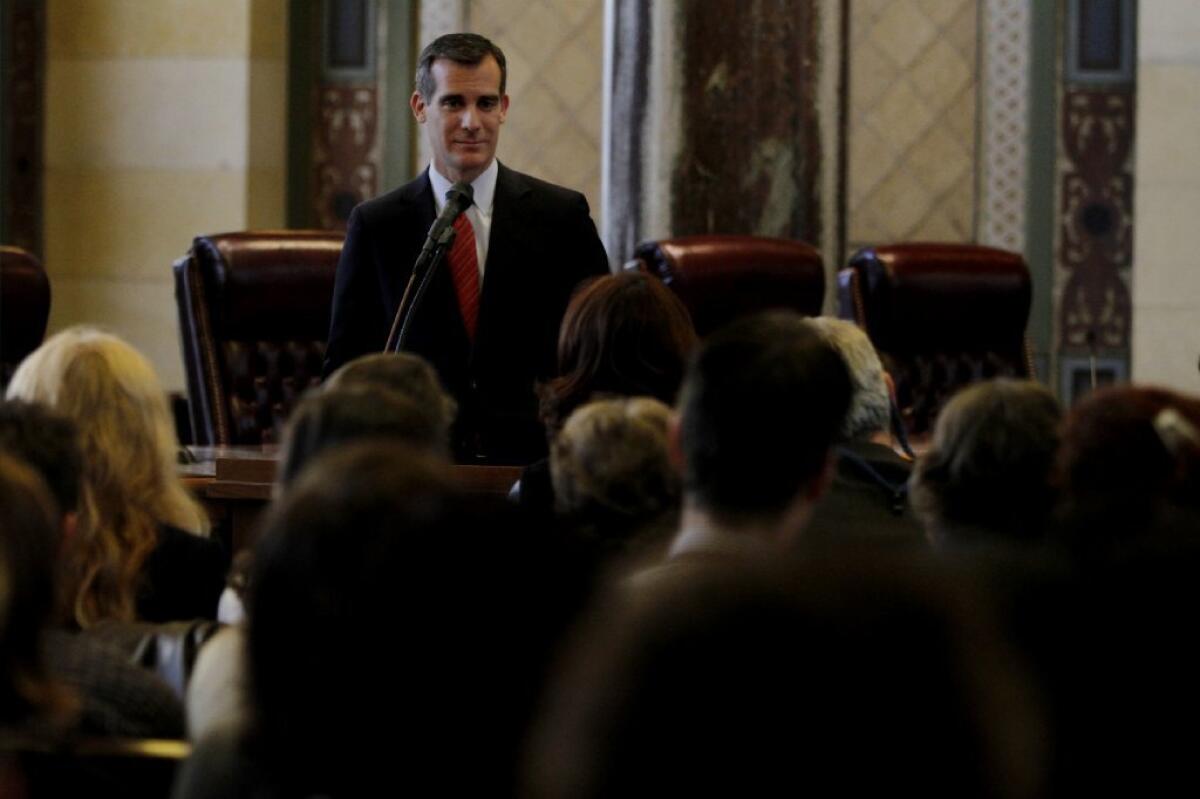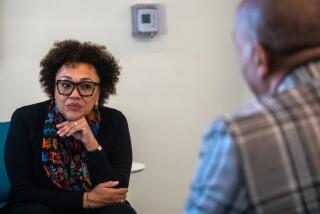Garcetti meets arts leaders to brainstorm, urge fresh thinking

This post has been updated. Please see below for details.
Addressing about 100 Los Angeles arts leaders Tuesday at City Hall, Mayor Eric Garcetti promised a more cohesive arts policy in which a variety of city departments will be attuned to fostering cultural opportunities for Angelenos while his administration banners L.A. to the world as the city “where creativity lives.”
While describing his audience as “spark plugs that can ignite” cultural growth in L.A., the mayor pointedly did not promise to fuel the engine with increased city government funding of the arts. The current core budget of the Department of Cultural Affairs is $8.96 million, down 38.5% from where it stood a decade ago, adjusting for inflation.
One of Garcetti’s most important arts policy decisions will be hiring a new general manager for the cultural affairs department, after choosing not to reappoint Olga Garay-English, who had served 6 1/2 years under former Mayor Antonio Villaraigosa. The department funnels about $3.4 million a year in grants to scores of nonprofit cultural groups and community festivals while overseeing the city’s public art program and a far-flung array of city-owned neighborhood arts centers and theaters.
CRITICS’ PICKS: What to watch, where to go, what to eat
“Los Angeles can do a better job promoting the arts than by subsidizing them,” Garcetti said during a 15-minute address that he followed with a 15-minute question and answer session. To that end, he said, he’ll try to make promoting and fostering L.A.’s arts and culture offerings “a value for the entire city government” instead of the sole domain of the Department of Cultural Affairs.
Garcetti said that a cohesive effort by city government and private arts organizations could inspire more of the private giving that’s crucial to the health of the nonprofit arts sector. “We have a tremendous amount of wealth in the city that’s waiting to be asked in the right way,” he said.
Among the ideas the mayor broached were bannering L.A.’s cultural attractions better at Los Angeles International Airport, and at Metro rail stops – something he said he’ll push for when he becomes chairman of the Los Angeles County Metropolitan Transportation Authority’s board in July.
He also pondered the possibility of turning city buses into “canvases” for L.A. artists’ work – acknowledging that the art would probably have to share space with revenue-generating advertising. “I know a lot of artists who would love to take a bus and have some fun with it,” Garcetti said.
PHOTOS: Arts and culture in pictures by The Times
Asking “why are our telephone towers so ugly?” the mayor said city government might have a role in creating something better: “Imagine Los Angeles pioneering fine design of cell towers.”
Garcetti said that a recent conversation with Michael Govan, the Los Angeles County Museum of Art director who has festooned the campus with a couple of buzzed-about outdoor landmarks, Chris Burden’s “Urban Light” sculptural array of old-fashioned street lights and Michael Heizer’s 340-ton land art boulder, “Levitated Mass,” got him wondering why L.A. doesn’t have “the equivalent of the Statue of Liberty as a greeting at the entry of the Port of Los Angeles, welcoming 43% of the goods that come into America.”
The people of France paid for the Statue of Liberty in the 1880s as a gesture of goodwill to America; the mayor didn’t go into who might underwrite a symbolic icon for the port of L.A.
Garcetti also suggested that Los Angeles host an annual or biennial major international conference devoted to Latino arts and culture. On that score, he said, “Miami is eating our lunch.”
The gathered arts leaders included Deborah Marrow, head of the J. Paul Getty Trust’s grant-making wing; Leni Boorstin, director of community affairs for the Los Angeles Philharmonic; and Jessica Cusick, cultural affairs manager for the city of Santa Monica.
Garcetti asked his audience to join in the communitarian thinking he’s promising from City Hall, instead of each organization tending only to its own garden: “Don’t come to me with ‘my theater company needs [fill in the] blank,’” Garcetti said. “I need you to think broadly. Think as the mayor. What would you do to transform Los Angeles into a cultural destination?”
The gathering did more than pay lip service to such input. After Garcetti left, several of his aides divided the audience into two groups. Each was asked to write down ideas for boosting L.A.’s standing as a cultural destination (and with it, the hotel taxes that are the primary mechanism for funding the Department of Cultural Affairs), and to list qualities the mayor should look for in the new general manager he’ll appoint.
After collecting the suggestions on post-it notes, aides summarized some of the main themes. Desired qualities in the next cultural affairs general manager included “someone good at fundraising,” “a strong public persona,” “someone who’s politically savvy” and “someone who’s approachable.”
“We’re going to read all of them and turn it into a working document” that the mayor will take into account in drawing up a job description for the position, said Emmett McOsker, a City Hall policy analyst whose domain includes arts and culture.
Garcetti’s ideas about municipal arts funding will become more specific by April 20, his deadline for submitting his administration’s first budget proposal, covering the 2014-15 fiscal year that begins July 1.
Danielle Brazell, executive director of Arts for L.A., the city’s leading advocacy and lobbying group for nonprofit arts groups, said that one of its priorities for the coming budget is persuading the mayor and City Council to revisit how L.A. spends the cultural affairs department’s share of hotel taxes.
Under city law, the equivalent of a 1% tax on hotel and motel room bills is set aside for cultural expenses – a total of $13.42 million in the current budget. Brazell said Arts for L.A.’s position is that the original intent of the ordinance reserving a share of hotel taxes for the arts was to funnel all of the money to grant-making, rather than spreading it more thinly by also using the money to cover administrative expenses.
Another priority, she said, is achieving more flexibility for another important municipal mechanism for arts-funding. Developers of non-residential projects costing more than $500,000 are obligated to pay a surcharge of 1% of their project’s budget to provide public art for their site, or they can make an equivalent cash payment, leaving it to city officials to decide how to spend the money for arts programming accessible to people in the project’s immediate vicinity.
Brazell said that more than $10 million in developers’ cash payments remains unused because of what she considers overly strict legal interpretations of where the money must be spent.
In addition to the core cultural affairs department budget of $8.96 million for salaries, grants, publications and supplies, the current city budget lists an additional $4.73 million for specific department costs including employee benefits and pensions, utilities, building maintenance and capital improvements, along with an additional $8.58 million in unspecified “related costs” and “other allocations.” The total comes to $22.85 million.
The core spending comes to about $2.30 per city resident, using the U.S. Census Bureau’s most recent population estimate of about 3.86 million. Brazell said L.A. ranks low in per capita arts funding compared with San Diego, San Francisco and other major cities.
She noted that government grants carry special significance for grass-roots groups, because the cultural affairs department recruits panels of experts to vet and rank grant proposals. Because of the review process, municipal grants are thought to confer a special seal of approval on an organization, which it can use to reassure prospective private donors that its work is worth supporting.
Since taking office in late June, Garcetti has appointed four new members to the Cultural Affairs Commission, a volunteer board that advises the Cultural Affairs Department and reviews and votes on proposals for public artworks paid for by the city and private developers.
The new appointees are Mari Edelman, a clinical psychologist, cello teacher and maker of film documentaries about her husband, former Los Angeles County Supervisor Ed Edelman, and her cello teacher, renowned USC professor Eleonore Schoenfeld; Javier Gonzalez, a consultant to political campaigns, unions and community groups; Sonia Molina, an endodontist and founder of an organization devoted to expanding opportunities for Salvadoran Americans; and Eric Paquette, senior vice president of production for Screen Gems. Garcetti also reappointed actor-writer Richard Montoya, a member of the Culture Clash comedy troupe who was originally installed by Villaraigosa.
Villaraigosa appointees Maria Bell, until this week the board co-chair of L.A.’s Museum of Contemporary Art, and Charmaine Jefferson, executive director of the California African American Museum in Exposition Park, continue to serve their unexpired terms.
Los Angeles County’s cultural funding far exceeds City Hall’s because of the county’s historic involvement in launching and supporting major public venues that are operated as partnerships between the county and nonprofit organizations it has contracted with to run and raise money for the facilities.
County cultural spending for the current fiscal year totals about $80 million, including $8.6 million for the Los Angeles County Arts Commission, which oversees grant-making programs and runs the John Anson Ford Amphitheatre, and subsidies to the Los Angeles County Museum of Art ($29.37 million), Music Center ($21.83 million) Natural History Museum of Los Angeles County ($14.96 million), Grand Park ($4.45 million) and La Plaza de Cultura y Artes ($1 million).
For the record: Jan. 14, 10:33 a.m.: An earlier version of this post incorrectly spelled artist Michael Heizer’s last name.
ALSO:
Arts funding at risk in Brown’s budget proposal
Mayor won’t rehire L.A. cultural affairs head Olga Garay-English
L.A. County, city arts budget proposals include cuts for many programs
More to Read
The biggest entertainment stories
Get our big stories about Hollywood, film, television, music, arts, culture and more right in your inbox as soon as they publish.
You may occasionally receive promotional content from the Los Angeles Times.







